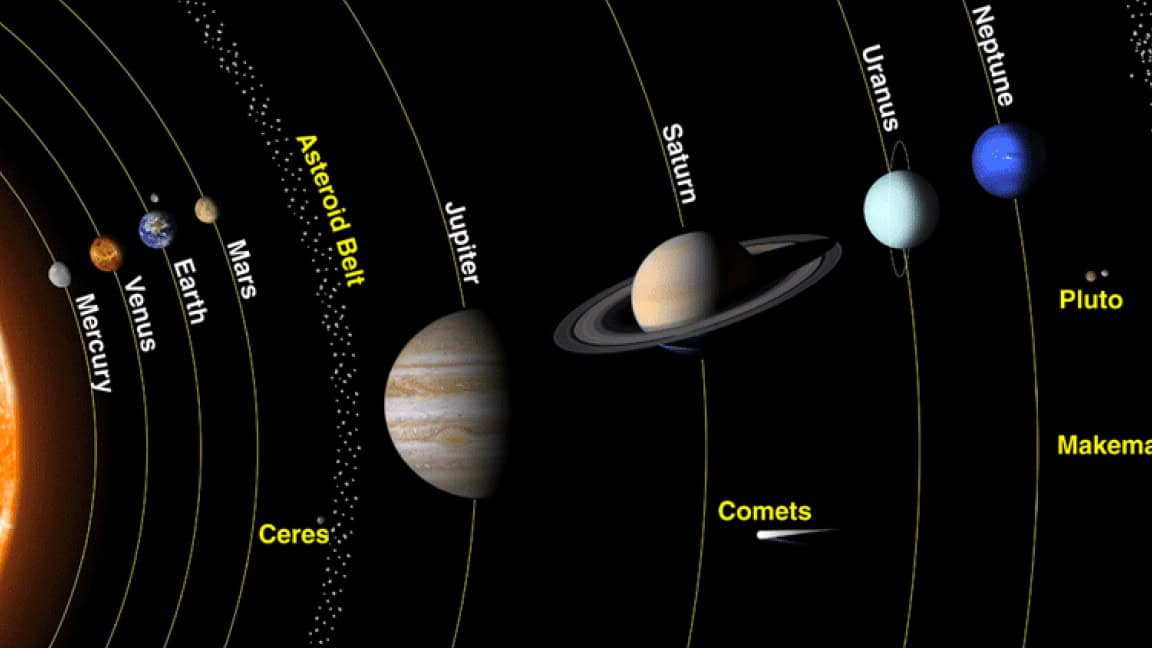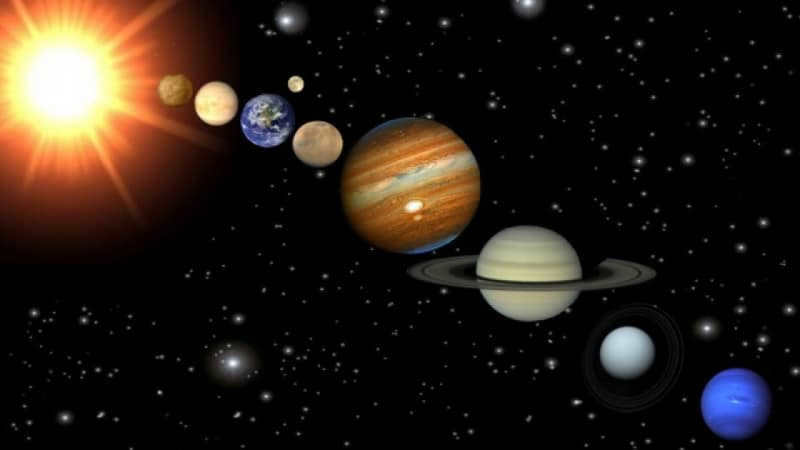
In the vast expanse of space, there exists a remarkable collection of celestial bodies known as the solar system. This mesmerizing ensemble consists of eight planets, each elegantly orbiting in a single plane, tracing circular paths around a brilliant central star. Scientists estimate that this extraordinary system came into existence approximately 4.57 billion years ago. At the heart of this celestial symphony lies the mighty Sun, a colossal star that reigns supreme as the heaviest entity within this cosmic ballet.
The solar system’s planets are located on the outskirts of the Milky Way galaxy. Our galaxy is a swirling gravitational mix of stars, planets, asteroids, dark matter, and clouds of gas and dust. The advent of powerful telescopes has allowed for a detailed study of the scale of the universe. Astronomers have astounded the Earth’s population with their findings. It turns out that our planet is not the focal point of the universe, but rather a tiny speck within one of the billions of solar systems in the Milky Way and the countless galaxies beyond. We will now delve into how our solar system came to be and the vast regions of space that exist.
The Origin and Composition of the Solar System
The solar system is a fascinating collection of celestial bodies held together by gravity. It consists of eight planets, which orbit the Sun in circular paths on a single plane. This incredible system formed approximately 4.57 billion years ago when a cloud of dust underwent gravitational compression. The Sun, the central star of the solar system, is significantly more massive than all the other planets combined. It has a staggering weight of 1.9855 x 10^30 kilograms, which is a whopping 332,946 times the mass of the Earth. Furthermore, the Sun has a density of 1.4 g/cm^3, making it 1.4 times denser than water.
Scientists have successfully determined the collective mass of the solar system, including planets, gas clouds, asteroids, and dark matter. This gravitational assemblage of objects has a weight of 1.0014 M☉. The unit of measurement is based on the mass of the sun: M☉ = (1.98847 ± 0.00007) x 1030 kg. This suggests that the vast majority of the solar system’s weight is attributed to the mass of the sun.
To facilitate a more comprehensive and accessible examination of celestial bodies, astronomers have categorized the Solar System into two groups:
During this time frame, the NASA space agency has identified 15,000 asteroids within our system, with an average diameter ranging from 140 to 915 meters or greater. Additionally, larger objects are more abundant, accounting for approximately 75% of all discovered space entities.
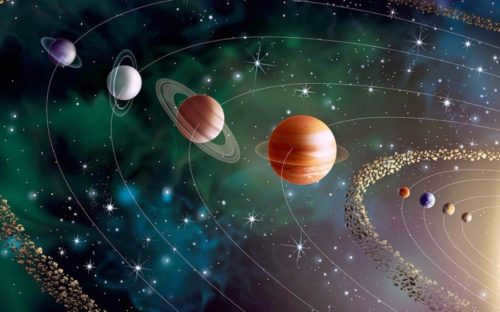
The inner part of the solar system
The components of the inner part include four planets similar to Earth and the asteroid belt. Most objects in this cluster are made up of metals and minerals. The orbits of the terrestrial planets and the asteroid belt are relatively close to the Sun. The radius of the inner part, measured from the Sun, is significantly smaller than the radius of the outer part, which extends beyond the asteroid belt.
Planets of the Earth group
The category of planets known as the terrestrial group is comprised of the relatively small celestial bodies, namely Mercury, Venus, Earth, and Mars. These planets possess an average density that is several times greater than that of water. They revolve slowly around their axes, each accompanied by one or more satellites, with the exception of Mercury and Venus, which have none. The Earth is orbited by the Moon, while Mars has two satellites, namely Phobos and Deimos. In terms of proximity to the Sun, Mercury is the closest, followed by Venus. Earth occupies the next position in the trajectory, and Mars is the outermost planet in the inner region.
Studying Mercury is challenging because of its close proximity to the Sun. However, scientists have discovered that it is the smallest planet in the inner region. Venus, on the other hand, is inhospitable with its constantly cloudy sky and sulfuric acid rain. The clouds are 15 kilometers thick, but the high temperature of 464 ℃ prevents the precipitation from reaching the surface, resulting in an atmosphere of carbon dioxide.
Mars is located 1.5 times farther from the Sun than Earth. It is smaller than Earth but larger than the Moon. Scientists have confirmed that Mars is uninhabited and its surface is mostly composed of iron oxides, giving it its distinct yellow-orange color. This is why Mars is often referred to as the red planet.
The solar system is located on the outskirts of the Milky Way galaxy, where the planets revolve around the sun. The Milky Way itself is a vast collection of celestial objects, including stars, planets, asteroids, dark matter, and clouds of gas and dust. The development of advanced telescopes has allowed astronomers to explore the vastness of the universe in great detail, revealing stunning discoveries to the people of Earth. These revelations have shown that our planet is not the center of the universe, but rather a tiny speck within one of billions of solar systems in the Milky Way, which is itself just one of many galaxies. In the following sections, we will delve into the origins of our solar system and explore the vast reaches of space.
Understanding the Solar System and its Origins
The solar system can be described as a collection of 8 planets that are held together by gravity and orbit around the central star, known as the Sun. This system is unique in that all the planets rotate in a single plane and follow circular paths around the Sun. The solar system is believed to have formed approximately 4.57 billion years ago through the gravitational compression of a cloud of dust. It is worth noting that the Sun, which is the central star, is significantly more massive than all the other planets combined. In fact, it weighs around 1.9855 x 10³⁰ kilograms, which is equivalent to 332,946 times the mass of the Earth. Additionally, the density of the Sun is 1.4 g/cm³, making it 1.4 times denser than water.
In order to facilitate a more comprehensive and convenient examination of celestial bodies, astronomers have categorized the Solar System into two distinct groups:
Throughout this specific timeframe, the NASA space agency has detected a total of 15,000 asteroids within our system, with an average diameter ranging from 140 to 915 meters or larger. Additionally, the larger objects are more abundant, accounting for approximately 75% of all identified space entities.
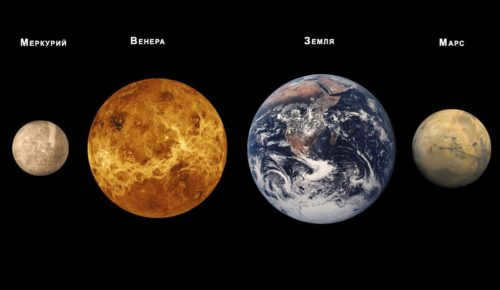
Astroid Belt
The region between the orbits of Mars and Jupiter is home to the Astroid Belt, a collection of various celestial bodies in a wide range of shapes and sizes. Within this belt, you can find large astroids known as minor planets, including Vesta and Hygeia. Astronomers theorize that the astroid belt formed after the destruction of the planet Phaeton. This hypothesis was proposed by the German astronomer Heinrich Wilhelm Olbers in the 17th and 18th centuries.
The Earth’s orbit and the asteroid belt do not intersect. However, when celestial bodies collide within the belt, their trajectories can be altered, causing them to venture further into space. Occasionally, asteroids collide with our planet, leaving behind ample evidence of this phenomenon. One such example is the destructive impact of the Tunguska and Chebarkul meteorites.
The outer realm of our solar system
Once we venture beyond the asteroid belt, we enter into the vast expanse of the outer region of our solar system. Within this realm, we find:
- gigantic planets accompanied by their moons;
- transneptunian objects;
- the Kuiper belt, home to countless asteroids and comets;
- the Oort cloud and its diffuse disk.
Within this outer realm, we also encounter centaur asteroids. Due to their significant distance from the Sun, these objects possess substantial reservoirs of ice, as well as traces of methane and ammonia.
Among the musings of astronaut scientists is the theory of the Sun’s companion, a dwarf star named Nemesis. Supposedly, its orbit lies beyond the Oort cloud. However, scientists have yet to confirm or disprove the existence of this enigmatic star.
Gigantic Planets
The massive celestial bodies in the outer region are commonly referred to as gas giants. These awe-inspiring planets are recognized as Jupiter, Saturn, Uranus, and Neptune. They possess an immense mass that accounts for 99% of all objects within the solar system. These colossal entities differ from terrestrial planets not only in their size but also in their composition. Jupiter and Saturn consist primarily of hydrogen and helium, while Neptune and Uranus contain substantial amounts of ice. Some astronomers even classify Neptune and Uranus as ice giants.
All four celestial bodies in our solar system that are classified as giants have rings surrounding them. However, only Saturn’s rings are observable through a telescope from Earth. The discovery of Saturn and Jupiter predates the discoveries of Uranus and Neptune, which were made in the 18th and 19th centuries with the introduction of advanced telescopes. During this time period, astronomers were able to study the giants of the outer region almost as extensively as the terrestrial planets.
NASA, the space agency of the United States, has played a crucial role in researching these celestial giants through the use of space probes. The Voyager 2 mission (1979-1989) was particularly successful in this regard. By sending a spacecraft to visit all four giants, scientists were able to gather valuable information about the previously unseen rings of Jupiter, Neptune, and Uranus. Additionally, the mission discovered other celestial objects. “Voyager 2” is still operational and continues to explore the outer region of our solar system.
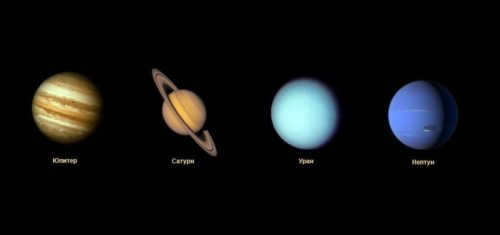
Comets
A comet is a celestial object primarily composed of ice, which is known as a space bolide. When a comet approaches the inner region of space, it is influenced by the gravitational pull of the Sun. This causes the ice within the comet to vaporize, resulting in the formation of a distinctive tail composed of gas and dust. There are two types of comets based on their life cycle: short-period comets and long-period comets. Short-period comets have a lifespan of about 200 years before disappearing, while long-period comets can travel through space for thousands of years. Additionally, some comets originate from neighboring systems and galaxies, entering our solar system as visitors from distant cosmic realms.
Centaurs
Centaurs, which are small planets and large asteroids that travel between the orbits of Neptune and Jupiter, are known as centaurs in the field of astronomy. These celestial bodies are named after the centaurs from ancient mythology. In terms of composition, they bear a striking resemblance to comets. The first centaur, named Chiron, was discovered in 1977. Although it began exhibiting comet-like activity after approaching the Sun in 1989, astronomers still classify it as a centaur. A similar situation occurred in 2005 with the centaur Echekl.
Currently, over 230 celestial bodies of this kind have been identified. The largest among them is called “1995 SN55” and measures approximately 278 kilometers in diameter. According to astronomers, due to the unpredictable nature of their orbits, centaurs are prone to being assimilated by colossal planets or obliterated in collisions with other celestial objects. Alternatively, they might simply vaporize, similar to comets.
Transneptunian bodies
Objects that travel beyond the orbit of Neptune are referred to as trans-Neptunian bodies (TNBs). This region of space is largely uncharted. Notable TNBs include Pluto, which was first observed in 1930 and was classified as a planet until 2006. It is currently recognized as a dwarf planet in the field of astronomy and is the second largest celestial body among transneptunian objects. The top spot for TNBs is occupied by Eride, a dwarf planet discovered in 2005.
Scientists studying astronomy have yet to come to a definitive conclusion regarding the exact location where the solar system comes to an end. Currently, two boundaries have been identified, known as the solar gravity and the solar wind. The heliopause represents the near boundary of the solar wind, while further out, the solar wind and the interstellar sphere intermingle.
The distance to the heliopause boundaries has been determined with great precision, measuring at approximately 100 astronomical units (a.e.) from the Sun. Additionally, it is believed that the gravitational force exerted by the Sun surpasses the galactic force known as the Hill sphere, extending a distance 1,000 times greater than that of the heliopause boundaries. What lies beyond these limits of the solar system remains a mystery.
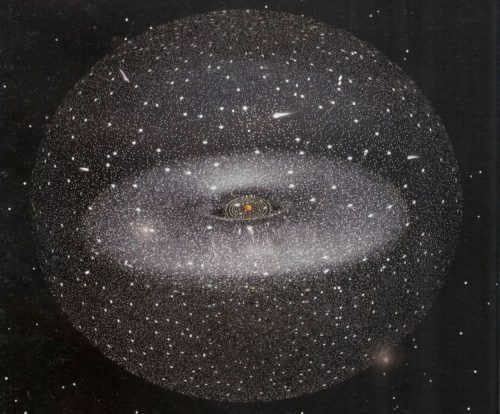
- The space between the stars and our sun is known as the heliosphere, where ionized gas moves at a speed of about 10 million km/h relative to our star.
- There is a region called the Oort Cloud, which is believed to be home to comets and asteroids. Astronomer Jan Oort proposed the idea in 1950 that our Solar System is surrounded by a sphere where long-period comets originate.
- Sedna is a trans-Neptunian object similar to Pluto, with a reddish elliptical orbit. It was discovered in 2003 and is thought to be part of the inner region of the Oort Cloud.
There is still much of the solar system that remains unexplored. However, contemporary scientists are continuously conducting research not only on the planets, but also on distant celestial bodies that are influenced by the Sun. It is crucial for individuals to have knowledge about the interaction between our solar system and the Milky Way galaxy, as well as the overall structure of the universe.
Take a quick tour of the solar system in just 6 minutes:
This piece discusses the Sun and its planetary system. For other interpretations, refer to the Solar System (meanings).
The Sun, planets, moons, and dwarf planets
(shown in true color and size to scale, but not to scale in terms of distances)
The Solar System is a system involving the Sun and various objects that revolve around it due to gravitational forces. This system came into being approximately 4.6 billion years ago when a massive interstellar molecular cloud collapsed under its own gravitational pull. The Sun accounts for the majority of the system’s mass, with 99.86% of it being concentrated there. The planet Jupiter contains most of the remaining mass. The innermost planets of the Solar System, namely Mercury, Venus, Earth, and Mars, are known as the Earth-group planets and consist primarily of rock and metal. In contrast, the outer part of the system is home to four giant planets that are significantly larger and more massive than their terrestrial counterparts. Jupiter and Saturn, the two largest among them, are gas giants primarily composed of hydrogen and helium. Uranus and Neptune, the next two in line, are ice giants composed mainly of substances with high melting points in relation to hydrogen and helium, such as water, ammonia, and methane. It’s worth noting that all eight planets have nearly circular orbits, which are situated close to the plane of Earth’s orbit referred to as the ecliptic.
There is a group of small planets known as detached objects located in the far reaches of the solar system. The number of these objects is a topic of debate. Some of these objects have enough mass to be rounded by their own gravitational pull, making them classified as dwarf planets. In total, astronomers generally recognize nine objects as dwarf planets: Ceres, Pluto, Ork, Haumea, Kwawar, Makemake, Gonggong, Erida, and Sedna. Additionally, there are various populations of small celestial bodies, such as comets, centaurs, and interplanetary dust clouds, that freely move between different regions of the solar system.
The heliosphere is a bubble-like region of interplanetary medium in the interstellar medium that is created by the solar wind, which consists of charged particles emanating from the Sun. The heliopause is the point at which the pressure of the solar wind equals the counteracting pressure of the interstellar medium. It extends all the way to the edge of the scattered disk. The Oort Cloud, believed to be the source of long-period comets, is thought to exist about a thousand times farther away than the heliosphere. In the Orion Arm of the Milky Way galaxy, which is located 26,000 light-years from the center, the solar system is situated. The Orion Arm is home to most of the visible stars in the night sky. The closest stars, including Proxima Centauri, are found in the Local Bubble, which is nearby and about 4.2441 light-years away.
- 1 Formation and evolution
- 2 Structure and composition
- 2.1 Orbits
- 2.2 Composition
- 2.3 Distances and scales
- 5.1 Inner planets
- 5.1.1 Mercury
- 5.1.2 Venus
- 5.1.3 Earth
- 5.1.4 Mars
- 5.2.1 Ceres
- 5.2.2 Pallada and Vesta
- 5.2.3 Asteroid groups
- 6.1 Outer planets
- 6.1.1 Jupiter
- 6.1.2 Saturn
- 6.1.3 Uranus
- 6.1.4 Neptune
- 8.1 Kuiper Belt
- 8.1.1 Pluto and Charon
- 8.1.2 Other
- 8.2.1 Eris and Gong Gong
- 9.1 Heliospheric Edge
- 9.2 Selected objects
- 9.3 Oort Cloud
- 9.4 Boundaries
- 10.1 Celestial neighborhood
- 10.2 Comparison with extrasolar systems
Origin and development
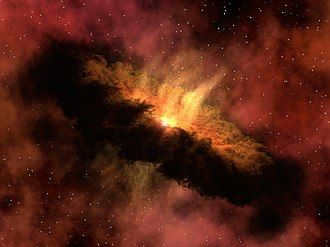
An illustration representing the protoplanetary disk that existed in the early stages of the solar system, giving rise to various celestial bodies including the Earth.
The solar system came into existence around 4.568 billion years ago through the gravitational collapse of a specific region within a large molecular cloud. This initial cloud, which was likely several light-years in size, gave rise to multiple stars. Similar to other molecular clouds, this cloud consisted primarily of hydrogen, with smaller amounts of helium and heavier elements that had been fused by previous generations of stars. When the region that eventually became the solar system, referred to as the pre-solar nebula, collapsed, the conservation of angular momentum caused it to rotate at an increasing speed. The center, where the majority of the mass accumulated, grew hotter and hotter compared to the surrounding disk. As the shrinking nebula continued to spin faster, it began to flatten into a protoplanetary disk with a diameter of approximately 200 a.u. (30 billion km; 19 billion miles), with a hot and dense protostar at its center. The planets formed by the gradual accumulation of the dust and gas in this disk, as these particles were attracted to one another by gravity and merged to form larger bodies over time. In the early solar system, there may have been hundreds of protoplanets, but they either merged with other bodies, were destroyed, or were ejected, resulting in the formation of planets, dwarf planets, and the remaining small celestial objects.
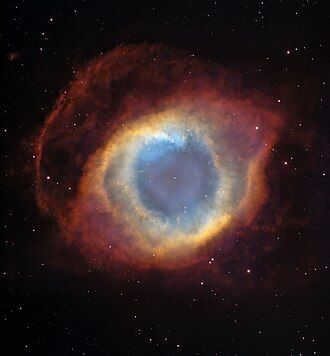
The Snail Nebula is a planetary nebula that bears resemblance to the nebula that will be formed when the Sun reaches the white dwarf phase.
After approximately 50 million years, the hydrogen in the center of the protostar reached a sufficient level of pressure and density to trigger thermonuclear fusion. As a result, the temperature, reaction rate, pressure, and density all increased until a state of hydrostatic equilibrium was achieved, with thermal pressure balancing the force of gravity. It was at this point that the Sun transitioned into its main-sequence phase, becoming a stable and long-lasting star. This main sequence phase, which spans a duration of around 10 billion years for the Sun, is significantly longer than all other phases of the Sun’s pre-sequence life combined, which total about two billion years. As the Sun’s core accumulates helium, its brightness gradually increases, with its initial brightness on the main sequence being only 70% of what it is today. Alongside this process, the solar wind emitted by the Sun has had a profound impact, creating a protective heliosphere and carrying away any remaining gas and dust from the protoplanetary disk, dispersing them into interstellar space.
The solar system is expected to remain relatively unchanged until the hydrogen in the Sun’s core is completely transformed into helium, a process that will take approximately 5 billion years. This transformative event will signify the end of the Sun’s life on the main sequence. During this time, the Sun’s core will contract as hydrogen fusion takes place in the shell surrounding the inert helium, resulting in a greater energy output compared to its current state. Simultaneously, the outer layers of the Sun will expand, reaching a diameter approximately 260 times larger than its current size, transforming the Sun into a red giant. As a result of this expansion, the surface temperature of the Sun will decrease, reaching a coldest state of 2600 K (2330 °C; 4220 °F) in comparison to its temperature on the main sequence.
It is predicted that as the Sun continues to expand, it will cause Mercury and Venus to evaporate and render Earth uninhabitable, possibly leading to its destruction as well. Eventually, the core will reach a temperature high enough to produce helium, resulting in the Sun burning helium at a faster rate than it burned hydrogen in its core. Due to its limited mass, the Sun will not be able to generate heavier elements through nuclear reactions in its core. As a result, its outer layers will be expelled into space, leaving behind a compact white dwarf with half the original mass of the Sun, but with the same size as the Earth. These expelled outer layers will form a planetary nebula, which will release some of the materials that were originally used to form the Sun. However, these materials will now be enriched with heavier elements like carbon, contributing to the interstellar medium.
Structure and composition
The term “solar” refers to anything related to the Sun and comes from the Latin word “sol,” which means “sun.” The Sun is the main gravitational force in the solar system, and its planetary system remains relatively stable and gradually changes over time as the planets orbit around it under the influence of its gravity.
Planetary Orbits
Explore the mesmerizing animations showcasing the orbits of the inner planets and the outer planets circling the Sun. The latter animation has been sped up by a factor of 100 compared to the former. Interestingly, Jupiter is located three times farther away from the Sun in comparison to Mars.
The planets and other substantial celestial bodies in our Solar System follow orbits that are closely aligned with the Earth’s orbital plane, known as the ecliptic. However, smaller icy objects like comets often travel in orbits that are at significantly steeper angles to this plane. In addition, most planets in our solar system possess their own satellite systems, where natural satellites, commonly referred to as moons, orbit around them. Notably, many of the largest natural satellites are in synchronous rotation, meaning that they always present the same face to their parent planet. Furthermore, the four colossal planets in our Solar System are adorned with planetary rings, which are delicate bands consisting of minuscule particles that orbit around them in perfect harmony.
The total amount of orbital and rotational momentum possessed by all the moving components of the solar system can be measured by the angular momentum. While the Sun is the most massive component, it contributes only around 2% of the total angular momentum. The majority of the remaining angular momentum is accounted for by the planets dominated by Jupiter, which is a result of their mass, orbit, and distance from the Sun. Additionally, comets may also make a significant contribution to the angular momentum.
Essay
The overall arrangement of the mapped areas of the solar system is comprised of the Sun, four smaller planets in close proximity surrounded by a collection of mostly rocky asteroids, and four massive planets encircled by the Kuiper belt made up mostly of icy objects. Astronomers occasionally informally categorize this arrangement into distinct regions. The inner solar system encompasses the four planets similar to Earth and an asteroid belt. The outer solar system lies beyond the asteroids, encompassing the four giant planets. With the discovery of the Kuiper Belt, the outermost regions of the Solar System have been recognized as a separate area consisting of objects located beyond Neptune.
The primary element of the Solar System is the Sun, a small star that holds 99.86% of the recognized mass of the system and has the most gravitational influence. The four most massive objects circling the Sun, the colossal planets, make up 99% of the remaining mass, with Jupiter and Saturn alone accounting for over 90%. The rest of the celestial bodies in the solar system (such as the four rocky inner planets, dwarf planets, moons, asteroids, and comets) collectively constitute less than 0.002% of the complete mass of the solar system.
The Sun, along with Jupiter and Saturn, is primarily made up of hydrogen and helium, accounting for about 98% of its composition. In the solar system, there exists a gradient of elements due to the thermal and light pressure exerted by the early Sun. Objects that are closer to the Sun and experience greater thermal and light pressure consist of elements with high melting points. On the other hand, objects that are farther away from the Sun are primarily composed of materials with lower melting points. This boundary, known as the frost line, marks the point in the solar system where these volatile materials can no longer fuse. The frost line is located approximately five times the distance between the Earth and the Sun.
Most objects in the inner solar system are primarily composed of rocks, including silicates, iron, and nickel. On the other hand, Jupiter and Saturn consist mainly of gases with extremely low melting points and high vapor pressures, such as hydrogen, helium, and neon. Ice, which includes water, methane, ammonia, hydrogen sulfide, and carbon dioxide, can exist in the form of ice, liquid, or gas in various parts of the solar system. These icy substances are abundant in the satellites of the giant planets, as well as in Uranus, Neptune (referred to as the “ice giants”), and numerous small celestial bodies located beyond Neptune’s orbit. Collectively, the gases and ice are referred to as volatiles.
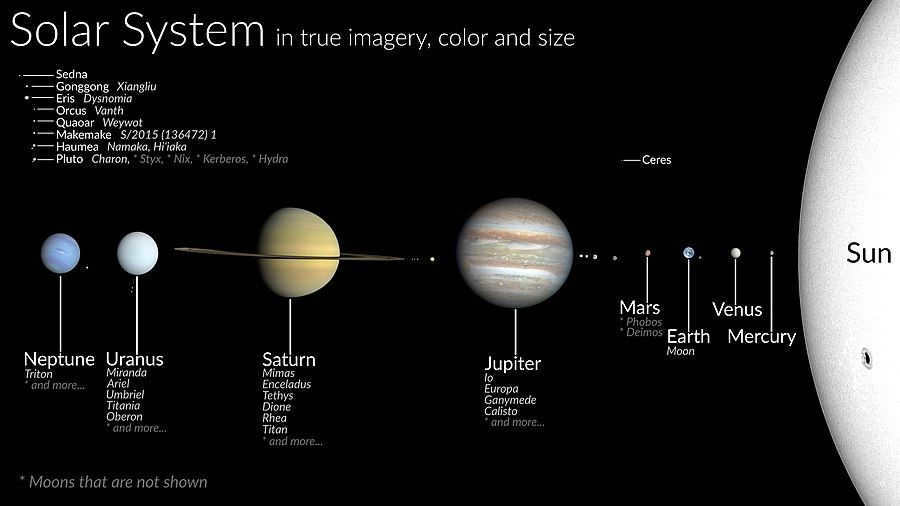
Size of the Sun, planets, dwarf planets, and moons depicted to scale and labeled. The proportion of distances between objects is not accurate.
The cosmos is boundless, containing numerous systems like the solar system, countless stars, asteroids, interstellar dust, and more. Situated at the heart of our celestial system is the Sun, an immense and scorching star. Orbiting the Sun are the planets, their moons, asteroids, and other celestial bodies. In terms of their proximity to the Sun, the planets are arranged in the following order: MERCURY, VENUS, EARTH, MARS – all belonging to the terrestrial group JUPITER, SATURN, URANUS, NEPTUNE – classified as giant planets. Pluto was once considered a planet, but it no longer holds that designation.
The distance from Earth to the Sun measures approximately 150 million kilometers. The Sun’s temperature reaches a scorching 13,500,000 Kelvin (1 Kelvin = -273° C). The Sun’s diameter is 109 times larger than that of the Earth. Its volume is equivalent to 1,303,600 Earth volumes, and its mass is 332,946 times greater than that of Earth. It takes approximately 8 minutes for a ray of light to travel from the Sun to the Earth.
The planet Earth is positioned as the third celestial body in proximity to the Sun. The concept of Earth’s spherical shape was originally proposed by PIFAGOR, and later confirmed by Aristotle. In terms of its dimensions, the Earth is slightly flattened at the poles by approximately 22 kilometers.
As for the specific measurements, the Earth has a spherical (geoid) shape with a polar radius of 6,356.8 kilometers and an equatorial radius of 6,378 kilometers. The average radius is calculated to be 6,371 kilometers. Additionally, the Earth boasts a volume of 10.832073×10^11 cubic kilometers, a mass of 5.9736×10^24 kilograms, and a surface area of 510,072,000 square kilometers. The equatorial circumference is estimated to be 40,000 kilometers.
The Earth exhibits an axial tilt angle of 66.5 degrees, and completes one full rotation on its axis in approximately 23 hours, 56 minutes, and 4.091 seconds. In terms of its orbital motion around the Sun, the Earth maintains a speed of 29.765 kilometers per second. It is worth noting that we traverse a distance of 81,000 kilometers per lesson. The Earth completes one full orbit around the Sun in approximately 365.2564 average solar days.
Consequences of the Earth’s movement: 1. The Earth’s motion around its axis results in the occurrence of day and night. 2. The change of seasons is caused by the Earth’s rotation around the Sun and the tilt of its axis.
What would happen if the Earth ceased to rotate on its axis?
The Moon is the Earth’s sole natural satellite. Its size is approximately 0.273 times that of the Earth. The volume of the Moon is about 0.020 times the volume of the Earth, and its mass is roughly 0.0123 times that of the Earth.
Tides are caused by the gravitational attraction between the Earth and the Moon.
A globe serves as a representation of the Earth and provides the most accurate depiction of objects. Maps, on the other hand, are not spherical and can introduce distortions.
Locate and indicate on a globe: the North and South Pole, the equator, the Northern and Southern Hemisphere, parallels, and meridians.
What celestial bodies comprise the solar system? What serves as the focal point of the solar system? Enumerate all the planets within the solar system. What types of movements does the Earth execute? What is the outcome of the Earth’s orbit around the Sun? What defines the Earth’s axis? What constitutes the equator? What are the poles? Sketch a depiction of the solar system within your notepad. Provide responses to the following inquiries:
Let us revert to the subject matter of the homework. Presented below are the recapitulation queries. Why did individuals not immediately uncover all aspects of Earth? What obstacles did they confront during their journeys? Specify at least 5 explorers. Elaborate on the life and achievements of one (any) of them. Are scientists currently making discoveries on Earth?
§ 3 Page 9, assignment #6 Diagram of the solar system. Homework.
About methodical developments, presentations, and notes

The Sun and the planets that make up the solar system
Assisting the teacher: an astronomy presentation called “The Sun and the planets that make up the solar system”.
A presentation for a research project titled “The Titius-Bode rule in the arrangement of the planets in the solar system”
A creative piece of work in the field of mathematics.

Presentation on the topic “Planets in the Solar System”
This presentation contains beautiful images of the planets and their satellites.
Geography lesson presentation segment on PLANETS IN THE SOLAR SYSTEM
The presentation offers educational segments on the following topics: “Planets in the Solar System” and “The shape and size of the Earth”.

Presentation “Planets of the Solar System”
This presentation is designed to assist in the study of the subject “Planets” during a geography lesson for sixth graders in a special education school.
The Earth – a planet in the solar system. A lesson on natural history for fifth graders
A unique lesson-concert format is utilized to teach natural history to fifth graders.
The activity can be utilized during the school self-governance day. It is introduced in the format of an interactive game.
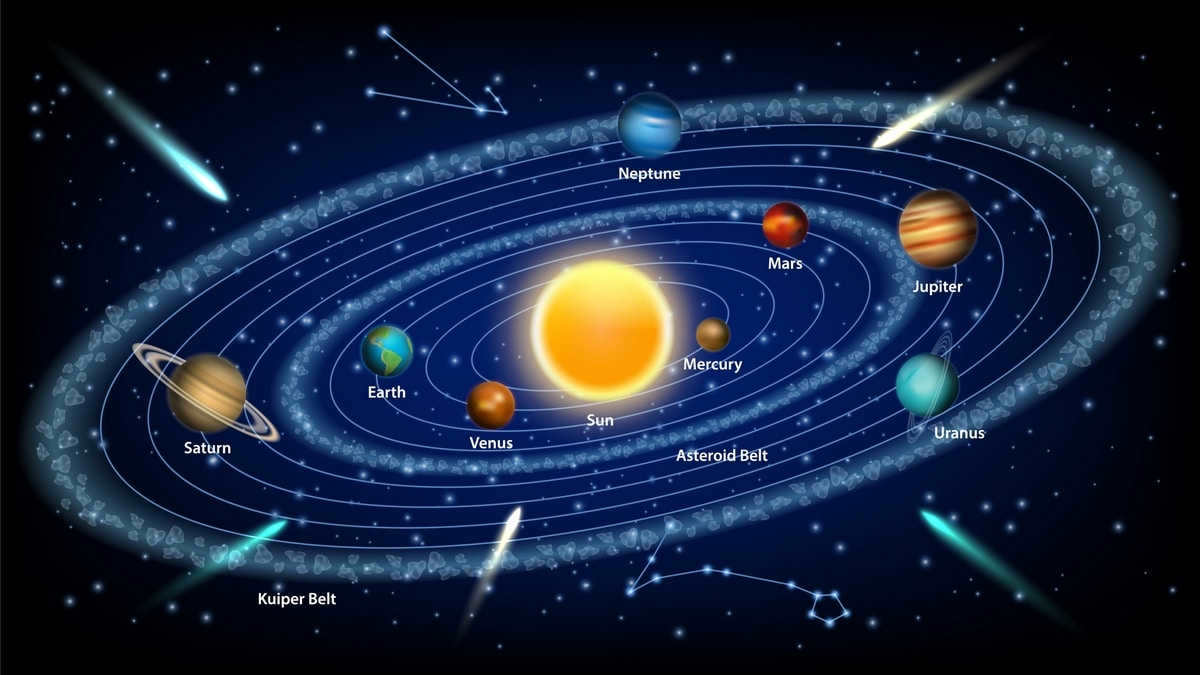
Our solar system, also known as the planetary system, contains a diverse range of celestial objects, including the sun, planets, dwarf planets, asteroids, and the origin of life itself on Earth. Occasionally, comets enter the inner regions of the solar system on highly elliptical orbits from the distant side of the system. A planetary system refers to a collection of non-stellar objects that are gravitationally bound and orbit around a star or a system of stars. Essentially, planetary systems encompass systems that consist of one or more planets, as well as other celestial bodies like dwarf planets, asteroids, natural satellites, meteorites, comets, and asteroids, along with identifiable entities such as circumstellar disks.
In this article, you will find comprehensive information about the planetary system, including its defining features and significance.
Understanding the Planetary System
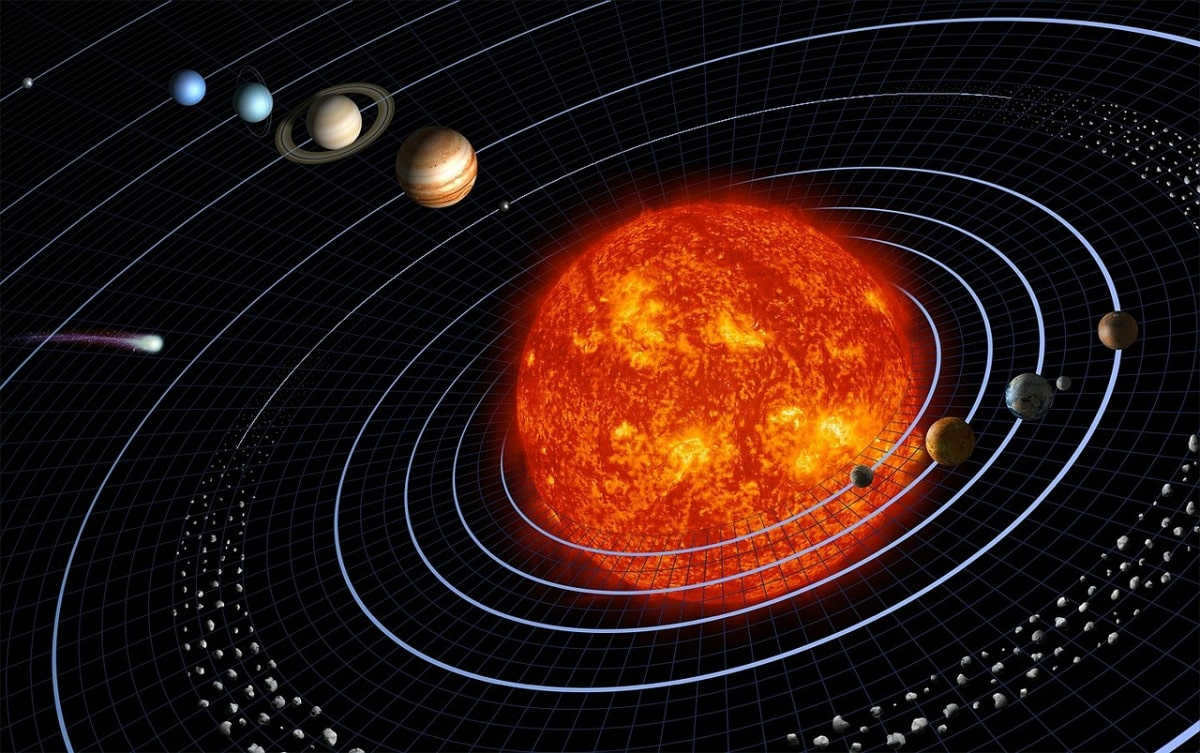
A celestial system is the term commonly used to refer to the solar system, which contains celestial bodies that are part of a binary star system and orbit around the Sun, Earth, and other planets.
The primary features of celestial systems are as follows:
- In the case of the solar system, it is comprised of the central star known as the Sun and its accompanying celestial body.
- It includes one or more central stars, referred to as the stellar system, and various objects that orbit around them.
- The Sun, along with its eight planets, gravitationally revolves in elliptical orbits within the solar system.
Categories of planetary systems
Classifications of planetary systems
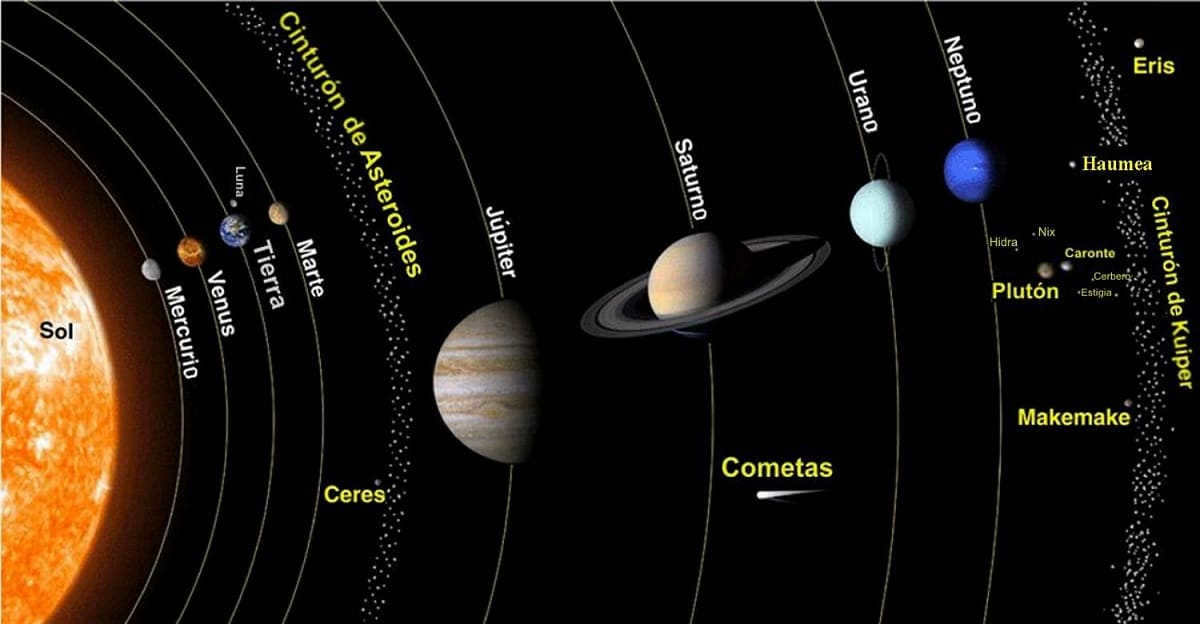
Astronomers categorize them into various groups. Particular kinds of stars are known to generate specific kinds of planetary systems, and they are organized based on the spectral class of the parent star. Stars in the main sequence, like the Sun, make up the majority of planetary system discoveries. They are typically classified by the size and type of their planets and their orbital arrangements.
The most frequently observed hot Jupiter system so far consists of a gas giant planet located very close to its star, and there have also been discoveries of hot systems similar to Neptune.
Various theories have been proposed to explain the formation of large planets in close proximity to their parent stars, such as scattering. Another common type of system consists of dust disks with large dust rings and comets.
Furthermore, it has been observed that protoplanetary disks are still in the process of forming. However, very few systems with suitable analogs have been discovered on Earth-like planets that are situated near their parent stars.
The formation of planetary systems follows a series of stages:
- The first stage, known as the collapse of the interstellar cloud, suggests that these systems originated from massive molecular clouds containing hydrogen, helium, lithium, and other heavy elements. It is from these clouds that stars and potentially planetary systems are born.
- The next phase involves the creation of planetesimals, which are collections of matter that come together to form larger objects. These particles merge to form structures that can stretch for several kilometers, resulting in a vast swarm.
- Following that is the stage known as the emergence of planetary embryos, which takes anywhere from 1 to 10 million years to complete. The collisions during this stage cause the embryos to fragment, leading to highly chaotic orbits shaped by gravity.
- Then comes the formation of the initial giant planets, also referred to as planetary embryos, which experience rapid growth. This growth process generates a significant amount of heat, causing the Earth to emit light like a star. As the growth continues, other giant planets form, rocky planets take shape, and excess gas is expelled.
Types of Models
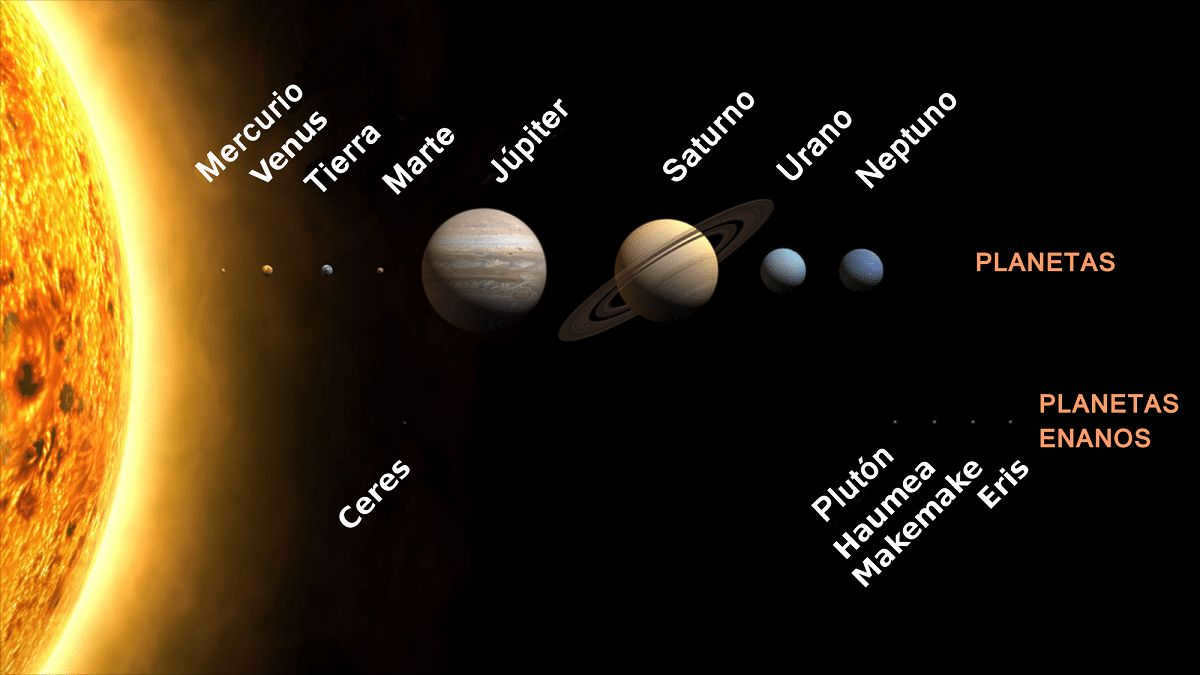
Throughout history, there have been various models of planetary systems, some of which are particularly noteworthy:
- Aristotle’s model: Aristotle believed that the earth was the most important and that it occupied the center of the universe. According to his model, the earth is composed of four elements – earth, water, air, and fire. He suggested that the sky consists of concentric spheres around the earth, with each sphere containing celestial bodies.
- Geocentric model: Ptolemy proposed a model in which the earth is positioned at the center and remains stationary, while the planets, moon, and sun orbit around it. Ptolemy developed a geometric theory that used mathematics to explain the movements and positions of the planets, sun, and moon.
- Heliocentric model: The center of the universe is the Sun, and the Earth and planets revolve around it in circular paths. The stars remain motionless, positioned away from the Sun, while the Earth rotates on its axis.
examples
Here, we present a few instances of planetary systems:
- Alpha Centauri: Proximity to Earth. The existence of planets orbiting their stars has yet to be confirmed. It is located 4.3 light-years away from our solar system and consists of two stars that potentially host planets.
- Epsilon Eridani: This planetary system has been detected and is the closest to Earth. Situated approximately 10.5 light-years away, it features a star slightly smaller than the Sun and a planet larger than Earth. The planet formed from a dust disk and an asteroid belt.
- Epsilon India: Comprising of a trio of stars, one of which is larger and about two-thirds the mass of the Sun, while the other two are brown dwarfs.
- Tau Kita: The presence of a star similar to our Sun, accompanied by five orbiting planets, makes this planetary system a potential habitat for life. Scientists speculate that two of the exoplanets might lie within the habitable zone.
Solar system
The solar system is the planetary environment where our Earth resides: a sequence of eight planets that continually orbit around a solitary star, the Sun.
Naturally, we are not the sole planetary system in existence. Across the galaxy and the universe, there are dynamic systems of forces revolving around the gravitational pull of one or more stars, making it reasonably certain that there are incalculable systems out there.
The local interstellar cloud, which our solar system is a part of, is situated within the local bubble of the Orion Arm, approximately 28,000 light years away from the central region of the Milky Way galaxy. This unique formation is believed to have originated around 4.568 million years ago when molecular clouds collapsed, resulting in the creation of a protoplanetary or stellar disk characterized by a chaotic arrangement of matter orbiting the sun. It is within this disk that the various celestial bodies and planets of our cosmic vicinity took shape.
Similar to other planetary systems, the objects within the Solar System follow elliptical orbits around the most massive star, which in our case is the Sun. The Sun, a G-type star, boasts a diameter of 1,392,000 kilometers and accounts for 99.86% of the total mass of the solar system.

